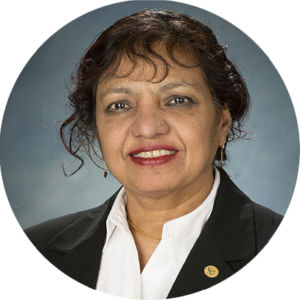
Sultana Nahar, PhD
Research Professor of Astronomy
The Ohio State University
Q&A
Who have you admired in your path into the sciences and what qualities did you see in them that you embody in your own path?
I learned in my school life that we are supposed to find and solve the mysteries of nature that Allah (God) created and use the knowledge for the benefits of human kind. Only the people of understanding can do them and I wanted to be one of them. This is what inspired me all my life. I found that detachment and devotion are crucial factors for doing science. However, I naturally seek to identify the qualities and practices of successful scientists, people and often define those with mine.
Can you tell us about a memorable moment in your career—a time when you knew you were working in your purpose?
I have been doing research in theoretical physics. Although I believed in the predicted features of the atomic process of photoionization that I obtained by mathematical computation, I did not have any proof of their existence. It was a moment of a very special joy of doing physics right in 2000 when Ron Phaneuf’s group at Nevada observed the features of oxygen photoionzation at ALS experimental set-up at Lawrence Berkeley National Lab for the first time, but could not explain them until my predictions, obtained two years earlier, were compared and gave details of the features.
What is one book or film you would recommend to a young person interested in a career in sciences?
I would recommend the TV series “Star Trek”, particularly the original series which is easy to follow, has scientific ideas that can be worked on, and adventures in new worlds.
Career Highlights
- Quoted as “The Iron Lady” for my extensive work on atomic processes of iron, which is difficult to study in astronomical objects
- Collaborated with Professor Anil Pradhan in our respective fields (mine on atomic processes and his on their astrophysical applications) to publish a graduate research handbook and textbook on atomic physics and astronomy. “Atomic Astrophysics and Spectroscopy”, a textbook for graduate students and handbook for researchers all over the world. It bridges two areas of topics, atomic physics and astronomy.
- Introduced the concept of “Resonant nano-plasma theranostics” for cancer treatment using x-ray spectroscopy as used for stars, black holes, resulting in significant media attention, and a feature in Astronomy magazine which noted the concept as a major contribution to astronomy for humanity and technology (e.g., GPS, wireless internet, and laser eye surgery using optics of Jame Webb Space Telescope).
- Promoted and introduced STEM education and research programs in 6 countries, Bangladesh, Egypt, India, Pakistan, Palestine, and the United States.
- Founded the International Society of Muslim Women in Sciences (ISMWS) at Ohio State in 2010. ISMWS has about 400 enthusiastic members from 32 countries, and has chapters at OSU, East Carolina University, India and Pakistan
- Presentation created on my work, “Sultana Nahar: A lady of vision and action” at a national seminar symposium in India
- Awarded the John Wheatley award in 2013 from the American Physics Society for philanthropic work, particularly for ISMWS
Biography
Dr. Sultana Nahar is a research scientist in the Department of Astronomy at Ohio State University. Dr. Nahar earned distinction of 1.B.Sc.Hons (Physics), 1st Class 1st & the Best Female Student of the University from the University of Dhaka, Bangladesh, as well as a M.Sc. (Theoretical Physics), 1st Class 1st from the University of Dhaka, Bangladesh, an M.A. (Quantum Optics) from Wayne State University, and a Ph.D. (Atomic Theory) from Wayne State University. Dr. Nahar has published approximately 190 publications on scientific work, delivered about 150 invited presentations, 38 articles on STEM education and research, and 84 invited and conference presentations. Dr. Nahar has been named a Fellow of the World Academy of Sciences (TWAS) of UNESCO, American Physical Society (APS), Bangladesh Physical Society, Bangladesh Academy of Sciences, as well as Woman Physicist of Month of APS.

